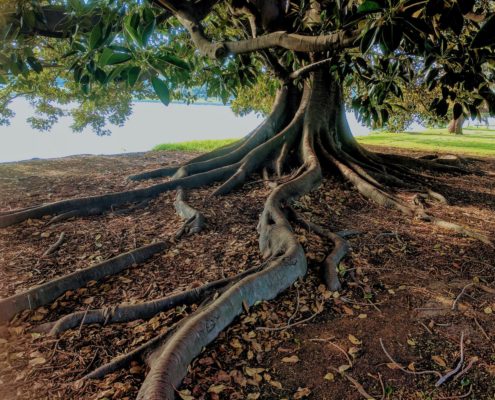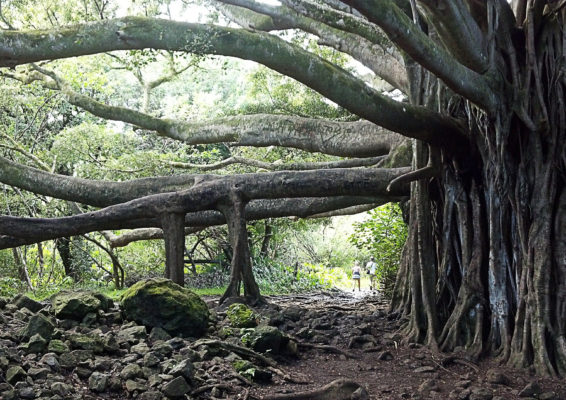To celebrate Valentine’s Day, Forests News asked staff at Center for International Forestry Research Center (CIFOR) about their true love. Here’s what they had to say:

Robert Nasi, Director-General of CIFOR
My one tree love is the baobab tree (Adansonia digitata) – A giant that grows upside down, stores water when there is none, whose fruits and leaves are edible, whose bark is medicinal. Simply beautiful in its tormented figure.

Himlal Baral, Senior Scientist – Climate Change, Energy and Low Carbon Development
I love the tamanu tree because it provides multiple values to humans as well as the environment. The tamanu tree gives a home to bees who make us honey, provides essential oils with medicinal healing and beauty properties, provides energy as it is a good source of biodiesel, and gives us valuable wood, all whilst growing on degraded land and restoring it at the same time … isn’t it beautiful?

Reza Julian, CIFOR Intern
I love the gooseberry tree; my grandma planted it in her backyard. When I was a child, me and her would harvest the gooseberries together. She made a glider for me and we would play together. Oh…that was very fun at that time.
Now my grandma has died, but whenever I see a gooseberry tree it always reminds me of her, and all the memories that we created together.

Yoly Gutierrez, Communications Specialist for Latin America
From Ceiba trischistrandra to Bertholletia excelsa, my two green crushes
Having been raised close to tropical dry (very dry) forests in northern Peru, I fell in love with their solitary and stout resilience. South American Ceibos (Ceiba trischistrandra) were so pretty to me, with their sharp, tangled branches, almost no leaves and cotton-like pompoms flourishing instead of flowers. As a little girl, I was fascinated with them, and would even ask my dad to stop the car in the middle of the road just so I could stare at them. They looked like giant, gentle, and green aliens to me.
Decades later, I was reading a CIFOR scientist’s research on the Brazil nut (Bertholletia excelsa) tree. I learnt how amazing these other giants were and how many people depend on them, on their fruits, on the environmental services they provide to the Amazonia, on their role to mitigate climate change, and preserve native biodiversity. I fell in love again.
Brazil nut forests (castañal, in Spanish) are only located in the Peru, Brazil and Bolivian Amazon. Once a year, at the end of the rainy season around March, their big and heavy fruits fall from the sky onto the jungle soil. Men and woman, and entire families look after these big, strong beauties over decades, trying to preserve them as a return for what they give. The three countries protect Brazil nut forests (castañales) from logging, but they are increasingly under pressure from deforestation, even they do have stewards and local families keep making efforts to reforest, to keep the animals that eat the young trees away and to promote different ways to sustainable use them. But that’s a different story.
It took four years for me to get me a date with Bertholletia excelsa. These forests are ‘hard to get’, which can only be a good thing! But here I am looking back at that day on September 14 of 2018 where I finally had my encounter. “If I ever visit a castañal, I will hug a tree for five minutes” I had told the scientist that had taught me about them.
Later, when I showed this photo [above] to a local Amazonian, I am told a local belief : The one who hugs a Brazil nut tree shall stay for long in this world. Let’s see.
Tegar Augusta – CIFOR Intern
I love the banyan tree because it’s reminds me of my girlfriend. We used to sit below a huge banyan tree that we wrote our names on, we didn’t know any better, so sorry banyan tree if it hurt? Almost twice a week we spent our time enjoying the sunset from the banyan. Maybe, it looks creepy to some with its size and hanging roots, but not for me, it’s just very lovely and full of memories.

Dina Satrio, Information Services Administrator
I love the Swietenia mahagoni tree because I love the curves and shades. In my eyes they look lovely: tall, green and have dense shades. It also fits to provide deep shade for my smaller plants.”

Amy Duchelle, Senior Scientist in the Climate Change, Energy & Low Carbon Development Team
I love CIFOR.
It was 2007. I had just finished two-and-a-half years of PhD fieldwork in the Amazonian border region of Brazil, Peru and Bolivia as part of a CIFOR global comparative study on poverty and environment. It was the most dynamic and diverse network that I had ever been part of.
One of my academic supervisors asks: Where do you want to work when you finish your PhD? Me: CIFOR. Him: Where else? Me: CIFOR. Him: Any other options? Me: No.
Yes, it was true love.
Somehow still going strong 10+ years later.

Carol Colfer, Senior Associate
I love the strangling fig tree because it has so many wondrous beliefs associated with it and is so supernaturally and practically important for so many people.

Florence Munoh, Administrative Assistant
I love the mango tree because it provides us with mangoes – the best fruit!

Iqbal Khairul, Intern
I love the chilli tree which I have planted at my house. Sometimes when I am about to eat, particularly instant noodle, i pick some of the chilli to complete the food. It doesn’t have to be so spicy, but it always tastes better. Isn’t it beautiful the way the tree can help us with even the simplest thing?
We want you to share Forests News content, which is licensed under Creative Commons Attribution-NonCommercial-ShareAlike 4.0 International (CC BY-NC-SA 4.0). This means you are free to redistribute our material for non-commercial purposes. All we ask is that you give Forests News appropriate credit and link to the original Forests News content, indicate if changes were made, and distribute your contributions under the same Creative Commons license. You must notify Forests News if you repost, reprint or reuse our materials by contacting forestsnews@cifor-icraf.org.



